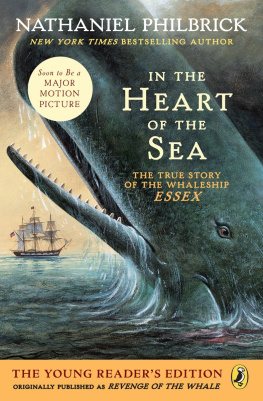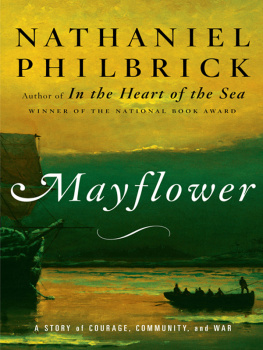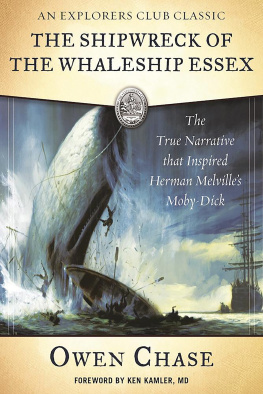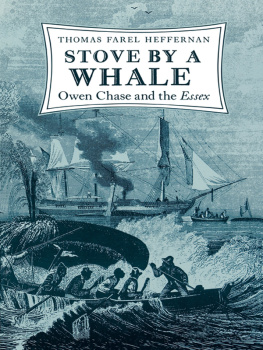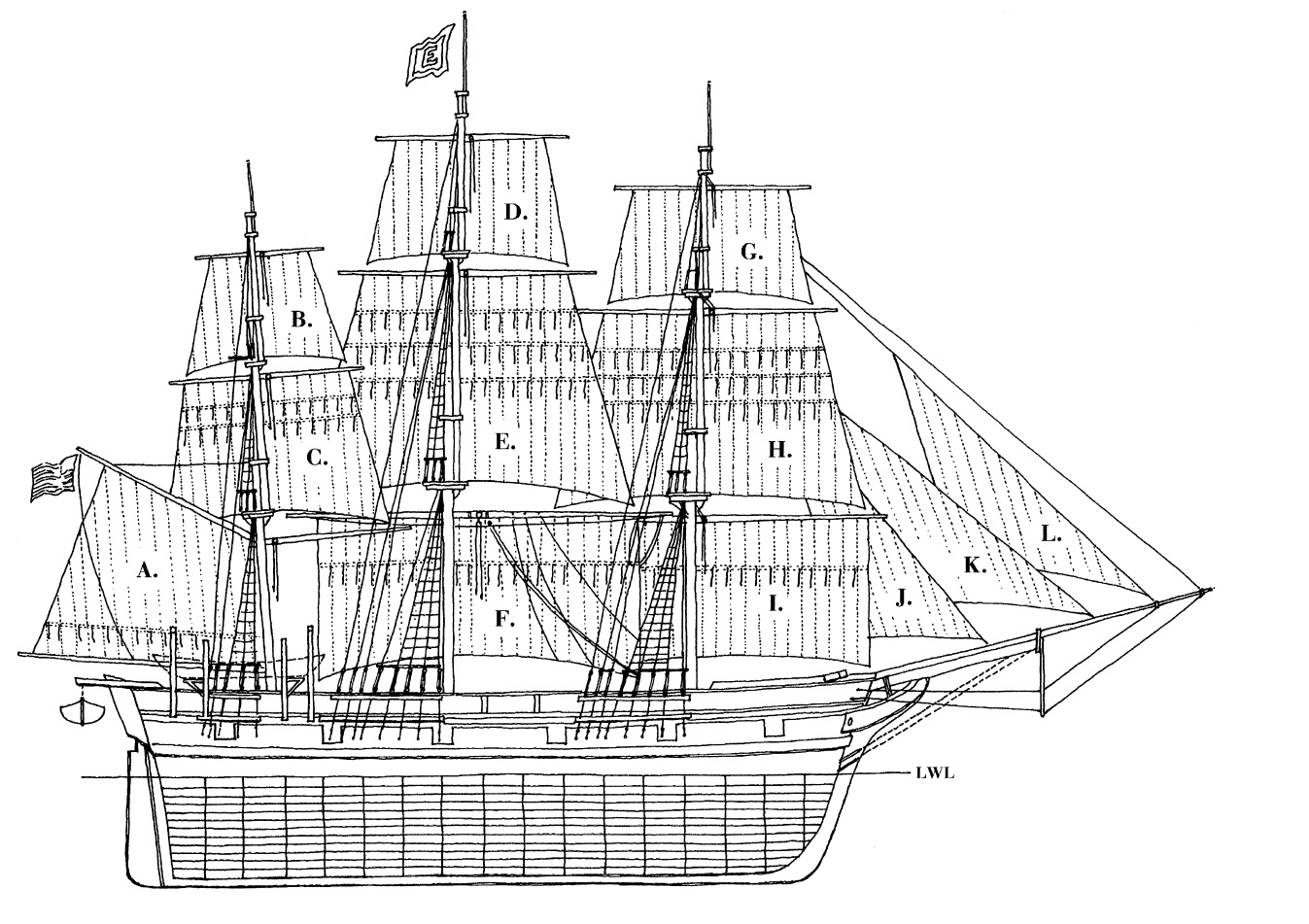O N BOARD .
Thomas Nickerson made his way down to his bunk and its mattress full of mildewed corn husks. As he faded off to sleep on the gently rocking ship, he surely felt what one young whaleman described as a great, almost overwhelming pride in my floating home.
That night he was probably unaware of the latest bit of gossip circulating through townof the strange goings-on out on the Commons. Swarms of grasshoppers had begun to appear in the turnip fields. [T]he whole face of the earth has been spotted with them... , Obed Macy would write. [N]o person living ever knew them so numerous. A comet in July and now a plague of locusts?
As it turned out, things would end up badly for the two ships anchored off the Nantucket Bar on the evening of August 11, 1819. The Chili would not return for another three and a half years, and then with only five hundred barrels of sperm oil, about a quarter of what was needed to fill a ship her size. For Captain Coffin and his men, it would be a disastrous voyage.
But nothing could compare to what fate had in store for the twenty-one men of the Essex.
[Readers] who long for adventure or have an interest in historical fiction will enjoy this book because of its graphic and historical detail.
VOYA
OTHER BOOKS YOU MAY ENJOY
Around the World in Eighty DaysJules Verne
Code TalkerJoseph Bruchac
Deadweather and SunriseGeoff Rodkey
The Great Wide SeaM. H. Herlong
The Mayflower and the Pilgrims New WorldNathaniel Philbrick
Treasure Island Robert Louis Stevenson
PUFFIN BOOKS
An imprint of Penguin Random House LLC
375 Hudson Street
New York, New York 10014

First published as Revenge of the Whale in the United States of America by G. P. Putnams Sons, a division of Penguin Putnam Books for Young Readers, 2002
Published by Puffin Books, a division of Penguin Young Readers Group, 2004
This edition published as In the Heart of the Sea The Young Readers Edition by Puffin Books, an imprint of Penguin Random House LLC, 2015
Text copyright 2002 by Nathaniel Philbrick
Image on title page and tailpiece is of a whale stamp used to record slaughtered whales in a ships log. (New Bedford Whaling Museum)
Images of harpoons on chapter openings from Dover Pictoral Archive Series.
Ship diagrams 2000 by L. F. Tantillo.
Maps by Jeffery L. Ward.
Illustrations Mystic Seaport, Mystic, CT.
Penguin supports copyright. Copyright fuels creativity, encourages diverse voices, promotes free speech, and creates a vibrant culture. Thank you for buying an authorized edition of this book and for complying with copyright laws by not reproducing, scanning, or distributing any part of it in any form without permission. You are supporting writers and allowing Penguin to continue to publish books for every reader.
THE LIBRARY OF CONGR ESS HAS CATALOGED TH E G . P . PUTNAM S SONS EDITION AS FOLLOWS :
Philbrick, Nat.
Revenge of the whale: the true story of the whaleship Essex / Nathaniel Philbrick.
p. cm. Summary: Recounts the 1820 sinking of the whaleship Essex by an enraged sperm whale and how the crew of young men survived against impossible odds.
Based on the authors adult book In the Heart of the Sea.
Includes bibliographical references (p. 161).
ISBN 978-1-101-99807-6
1. Essex (Whaleship)Juvenile literature. 2. ShipwrecksPacific OceanJuvenile literature.
[1. Essex (Whaleship). 2. Shipwrecks. 3. Whaling. 4. Survival.] I. Title.
G530.E77 P46 2002 910.9164dc21 2002000667
Version_1
To Melissa
C ONTENTS
Illustrations appear .
Maps appear .
Gallery of photographs .
C REW OF TH E E SSEX
CAPTAIN
George Pollard, Jr.
FIRST MATE
Owen Chase
SECOND MATE
Matthew Joy
BOATSTEERERS
Benjamin LawrenceObed HendricksThomas Chappel
STEWARD
William Bond
SAILORS
Owen CoffinIsaac ColeHenry DeWittRichard PetersonCharles RamsdellBarzillai RaySamuel ReedIsaiah SheppardCharles ShorterLawson ThomasSeth WeeksJoseph WestWilliam Wright
CABIN BOY
Thomas Nickerson
Sail Plan of the Whaleship Essex
A. mizzen sail
B. mizzen topgallant sail
C. mizzen topsail
D. main topgallant sail
E. main topsail
F. main course or mainsail
G. fore topgallant sail
H. fore topsail
I. fore course or fore sail
J. fore topmast staysail
K. jib
L. flying jib
Deck Plan of the Whaleship Essex
A. windlass
B. forecastle companionway
C. foremast
D. tryworks
E. main hatch
F. mainmast and pumps
G. cookhouse
H. spare whaleboat mounted on overhead rack
I. mizzenmast
J. aft companionway
K. wheel
L. spare whaleboat
M. starboard boat
N. aft larboard boat
O. waist boat
P REFACE
February 23, 1821
L ike a giant bird of prey, the whaleship moved lazily up the western coast of South America, zigging and zagging across a living sea of oil. For that was the Pacific Ocean in 1821, a vast field of warm-blooded oil deposits known as sperm whales.
Harvesting sperm whalesthe largest toothed whales in existencewas no easy matter. Six men would set out from the ship in a small boat, row up to their prey, harpoon it, then attempt to stab it to death with a lance. The sixty-ton creature could destroy that boat with a flick of its tail, throwing the men into the cold ocean water, often miles from the ship.
Then came the enormous task of transforming a dead whale into oil: ripping off its blubber, chopping it up, and boiling it into the high-grade oil that lit the streets and lubricated the machines of the Industrial Age. That all of this was conducted on the limitless Pacific Ocean meant that the whalemen of the early nineteenth century were not merely seagoing hunters and factory workers but also explorers, pushing out farther and farther into a scarcely charted wilderness larger than all the earths landmasses combined.
For more than a century, the headquarters of this global oil busi-ness had been a little island called Nantucket, twenty-four miles off the coast of southern New England.
It was a Nantucket whaleship, the Dauphin, just a few months into what would be a three-year voyage, that was making her way up the Chilean coast. And on that February morning in 1821, the lookout saw something unusuala boat, impossibly small for the open sea, bobbing on the swells. The ships captain, the thirty-seven-year-old Zimri Coffin, trained his spyglass on the mysterious craft with keen curiosity.

